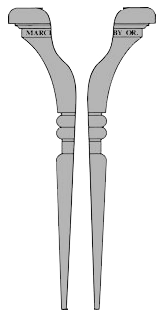404 Beavercreek Rd, Suite 240
Oregon City, OR 97045
M-F 10:00am to 5:00pm
503-263-2456 // info@marcinkiewicz.com
Anatomy of a Mouthpiece







Rim
There are three major components that make up the rim. These are the rim facing; the outside diameter; and the inner edge, or bite. The rim contour is the main contact area of the mouthpiece. This fit of this feature is determined by the maxiofacial features (lips, teeth, and gums) of the individual. The outside diameter and rim width are determined by whatever is comfortable for the player. The mouthpiece should not hurt to play. The inner edge is the most critical feature of the rim. The bite should not be so sharp that it cuts into the flesh, but not so flat as to provide no bite. Bite is defined by the ability to hold the mouthpiece to the lips without excess pressure, and still feel comfortable.
Cup
The cup reflects the player's choice for quality of sound by both depth and shape. There are three basic
types of cups: C-cup, V-cup and the Marcinkiewicz modified C/V-cup. A C-cup offers the player a darker
sound. A V-cup offers efficiency. Our modified C/V-cup can offer the darker sound of a C-cup with the
efficiency of a V-cup. The air stream is channeled through the center of our uniquely designed cup and
venturi, through the backbore and directly into the horn to produce the desired sound. In short, the
modified C/V-cup is easier to play. There is a difference between a C-cup and a V-cup and not every player
can play both. The C/V-cup offers more choice to a wider range of players.
A deeper cup offers a darker sound and a shallower cup offers a brighter sound. Our modified C/V-cup
mouthpieces can be shallower and still give the player more flexibility and versatility verses the C-cup
or V-cup alone. Again, this situation is because the modified C/V-cup is more efficient.
Cup depth alone does not always dictate the sound quality. The overall shape of the cup factors in greatly.
You may find mouthpieces in this catalog that have similar dimensions (inside cup diameter, outside cup
diameter and depth) but play completely differently. Generally, this is due to a variation in cup shape.
It is possible for a mouthpiece that has a shallower cup than another mouthpiece (again, with same rim
dimensions) to have greater overall cup volume than the deeper mouthpiece, due to the contours of the cup.
The inside cup dimension measurement is a critical piece of information any mouthpiece and the consistency
and accuracy of the measurement is vital for the player. An accurate and consistent measurement allows a
player to know exactly what dimension is employed and a baseline for adjustments. We measure our trumpet,
cornet, flugelhorn and French horn mouthpieces at .032 in. from the top of the rim to a consistent point.
Tenor trombone, bass trombone and euphonium mouthpieces are measured .047 in. from the top, tuba and
sousaphone mouthpieces .064 in. from the top. Fractions or approximations do not work the same way.
For example, our No.308/11/2C trumpet mouthpiece and the No.E1 both compare to a 11/2C, but have different
inside bites. This is very hard to detect by the naked eye. The precision of our measurements allows the
difference to be evident. We took the guess work out.
Throat
This is another critical area of the mouthpiece. The entrance determines how smoothly the air moves from the cup through the venturi or drill. If the entrance is too sharp it creates more resistance. If the entrance is more open, less resistance is generated. By applying the correct taper to the throat entrance, efficiency is enhanced, hence the modified C/V cup.
Venturi
Generally, the size of the opening determines the amount of air the player can put through the instrument. Standard size for a trumpet is #27 (0.144"), trombone is A (0.234"), and tuba is N (0.302"). There are a wide variety of throat sizes aside from the standard mentioned above. See the Venturi/Drill Chart for other sizes in each category.
Backbore
Perhaps the second most critical area of a mouthpiece, the backbore either spreads the sound or channels it depending on how tight or open the design. The backbore influences the color, nuance and timbre of the mouthpiece. If you put a large backbore with a large cup mouthpiece the result will be a very warm, compassionate mouthpiece with feeling and depth of sound. The same mouthpiece with a tighter backbore will focus the sound that is being created, equalizing the lower end and accenting the upper end of upper harmonics. Our backbore designs enhance the player's ability to move easily throughout all registers of the instrument with uniformity of timbre and feel. Please note that the wrong backbore can make the mouthpiece play sharp or flat.
Shank
We use a standard Morse taper. We make the Morse taper exact at .050" per inch -No more and no less! Please note, if your mouthpiece goes all the way in and touches the lead pipe it creates less resistance. There is a danger that the lead pipe will flair creating a burr resulting in resistance in the wrong place. If the mouthpiece does not go in far enough and is more than a quarter inch away form the lead pipe, too much resistance is produced. This causes an undesirable sound for certain notes.
